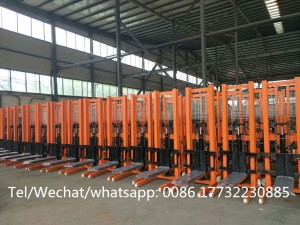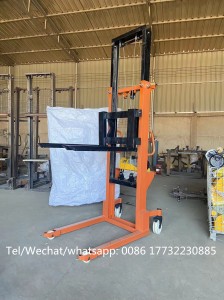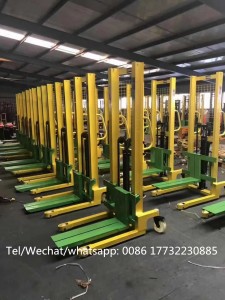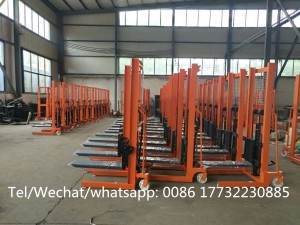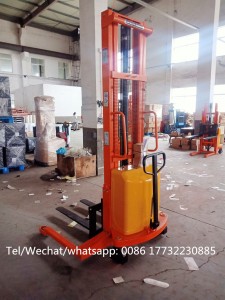A stacker forklift, also known as a walkie stacker or pedestrian stacker, is a type of forklift designed for lifting and stacking palletized loads. It is operated by a pedestrian who walks behind or beside the machine while guiding it. Stackers are commonly used in warehouses, distribution centers, and manufacturing facilities where there is a need for vertical stacking and maneuvering in tight spaces. Here are some key features and information about stacker forklifts:
Design and Components: A stacker forklift consists of a chassis, forks, mast, and controls. The chassis is equipped with wheels or rollers for mobility. The forks are attached to the mast and can be raised and lowered to lift and transport loads. The mast contains the hydraulic system and lifting mechanism. The controls, typically mounted on the handle, allow the operator to operate the stacker and control lifting, lowering, and steering functions.
Lifting and Stacking: Stackers are primarily used for vertical lifting and stacking of pallets or loads. They have a lifting mechanism powered by an electric motor or hydraulic system. The forks can be raised and lowered to the desired height to pick up or deposit loads onto racking or shelving systems. Some stackers also have the ability to tilt the forks for improved load stability.
Load Capacity: Stackers come in various load capacity options, ranging from a few hundred kilograms to several tons. The load capacity should be selected based on the weight of the loads that need to be lifted and stacked.
Power Source: Stackers can be powered by electricity or manual operation. Electric stackers are powered by batteries and are suitable for indoor use. They offer quieter operation, reduced emissions, and longer operating times compared to manual stackers. Manual stackers, on the other hand, require physical effort from the operator to manually pump the hydraulic system for lifting and lowering.
Maneuverability and Compact Size: Stackers are designed to be compact and maneuverable, making them suitable for narrow aisles and confined spaces. They are often used in areas where larger forklifts cannot operate efficiently. The pedestrian-operated design allows for improved visibility and control in tight areas.
Safety Features: Stackers are equipped with safety features to protect operators and prevent accidents. These may include features such as emergency stop buttons, horn or audible alarms, anti-roll-back mechanisms, and safety switches that prevent operation when the operator is not present. Operators should receive proper training on stacker operation and safety protocols.
Applications: Stackers are commonly used for various material handling tasks, including stacking and retrieving palletized loads from racking systems, loading and unloading trucks, and moving loads in confined spaces. They are particularly useful in areas where space is limited or where the use of larger forklifts is not practical.
When operating a stacker forklift, it is important to follow proper safety procedures, including wearing appropriate personal protective equipment, inspecting the equipment before use, and adhering to load capacity limits. Regular maintenance and inspections should be conducted to ensure the stacker is in proper working condition. Operator training and adherence to safe operating practices are crucial for a safe and efficient lifting and stacking operation.
Post time: Aug-28-2023





